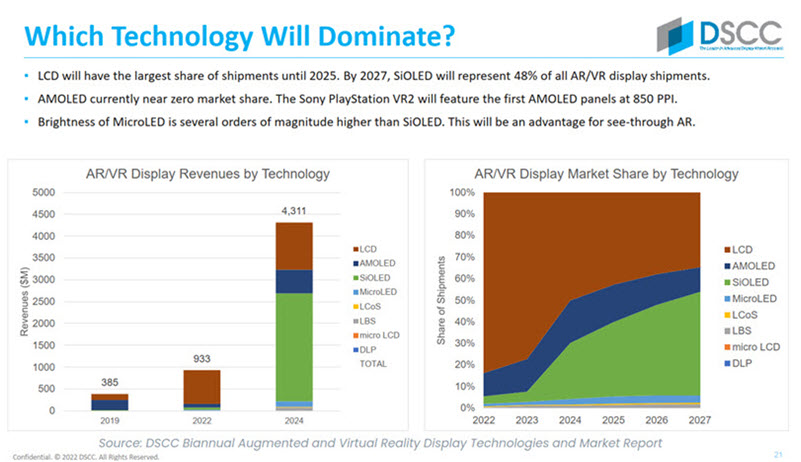Display requirements are different for VR (and pass-through AR) and see-through AR. For VR (and pass-through AR) most displays are based on TFT LCD and AMOLED. In general, immersive display needs are as follows:

- High resolutions (high pixel density to reduce or eliminate the screen door effect).
- High brightness
- High contrast
- Wide color gamut
- High refresh rates (and short duty cycle to reduce motion sickness).
- High PPD (Pixel Per degree)
- Widest Field of View (FOV)
- Compact design
See-through AR needs very high brightness display to match the ambient light; the display needs to be small and power efficient to make the headset thinner and lightweight. Currently all headsets for see-through AR are based on microdisplay (DLP, Micro-LCD, LCoS, Micro OLED) or laser beam scanner (LBS).
LCD: Strong presence through high PPI and MiniLED
LCD is the leading technology in the VR market. Advanced LTPS TFT LCD is generally used for VR for high resolutions displays. It has already achieved more than 1200PPI. Companies such as JDI are targeting 2000 to 2500PPI resolutions in the next two to three years. Local dimming backlights with miniLED can lower power consumption and optimize the image for higher contrast. Fast response LC (liquid crystal) with high-speed backlight switching can offer a clearer image. According to JDI an impulse display, needed for better motion display, is realized by applying a global blinking backlight. The efficiency of backlight blinking results in shortening the display “on” time and minimizes “ghosting”, thereby providing a clearer image. According to LCD suppliers:
LCD is the best technology for 2-3-inch size displays for VR-HMD as it provides a wide field of view (HFV), which is a critical factor for an immersive VR-HMD.
Companies are also starting to use miniLED backlights for LCD for higher contrast and lower power consumption. The Varjo Aero ($1900) has two miniLED LCDs and the Pimax Reality (12K QLED) ($2399) has two miniLED LCD panels (200Hz refresh rates and QD layer for high color gamut, 6K per eye resolution with 1200PPI) and are already in the market.
Image:2 Source:JDI.com
OLED on Silicon (SiOLED): Poised for dominance with very high resolution & high luminance
OLED on Silicon (OLED Micro Display) are viewed through an optical system and generally have higher pixel density than AMOLEDs. OLED on silicon (SiOLED) is a common technology used to implement MicroOLEDs. It can be used both for VR and see-through AR. MicroOLED displays can be generally categorized into RGB OLED and White OLED (WOLED) types. However high resolution RGB OLED microdisplays still face challenges due to a shadow effect during the deposition process using FMM (Fine Metal Mask).
White OLED uses a color filter to generate image which can achieve high PPI (4000PPI). However the color filter absorbs a very high percentage of the emitted light and that limits maximum brightness for microOLED. Sony has been using microLens technology to increase the peak brightness of its OLED microdisplays.
Kopin has developed a trio stack architecture to increase brightness.
eMagin has developed a direct patterning RGB OLED micro display. It has achieved 10,000 nits of brightness in a WUXGA (1920 x 1200) OLED microdisplay, made by direct patterning (eliminating the color filter) of red, green, and blue(RGB) sub-pixel emitters on the backplane. The red and green emitters were made from phosphorescent materials and blue from fluorescent material. This has enabled significant improvement in efficiency and lifetime. They have roadmap to develop 30,000 nits full color peak luminance.
According to DSCC forecast, LCD will have the dominant shipment share in the AR/VR market up to 2025. By 2027, SiOLED will represent 48% of all AR/VR display shipments. DSCC expects Apple’s new Reality Pro Product (2H 2023) to have dual microOLED plus one AMOLED display with a pixel density of >3000 PPI. Apple’s adoption of SiOLED technology and technology progress will help SiOLED to gain higher market share in future. According to the company forecast, VR (including pass through AR) will be a much bigger market for display suppliers than see through AR.
QD and MiniLED LCD-based VR/MR devices by the use of muti zone blinking backlights, can enable LCD to have higher brightness, very high contrast, excellent HDR, compact form-factor, superior power efficiency and higher display performance. MiniLED-based products with QDs with higher picture quality, more competitive prices, higher product availability and brands focus (for product differentiation) can empower LCD to keep higher market share and also help to open up new opportunities for higher revenue. (SD)
Sweta Dash, President, Dash-Insights
Sweta Dash is the founding president of Dash-Insights, a market research and consulting company specializing in the display industry. For more information, contact [email protected] or visit www.dash-insights.com
Part 1 was published yesterday. The two parts will count as only one if you have a free subscription to Display Daily.


